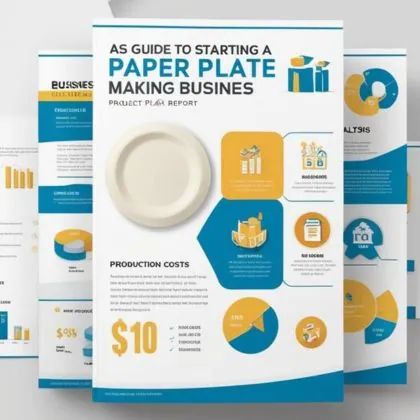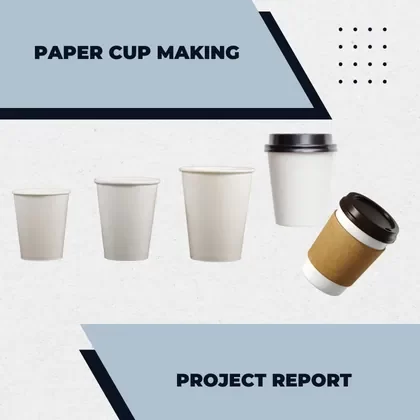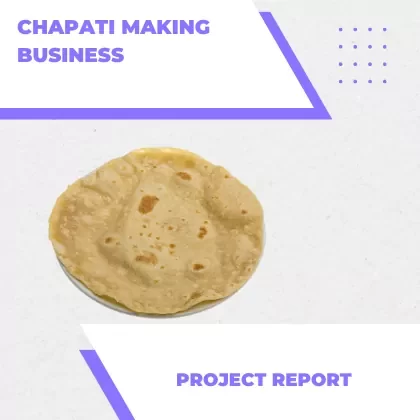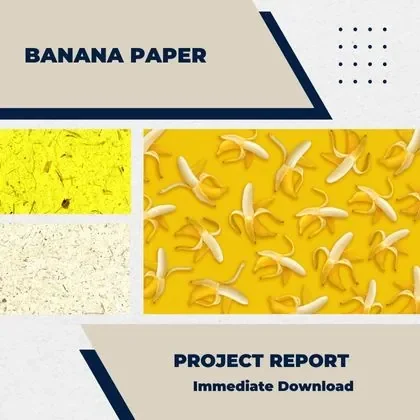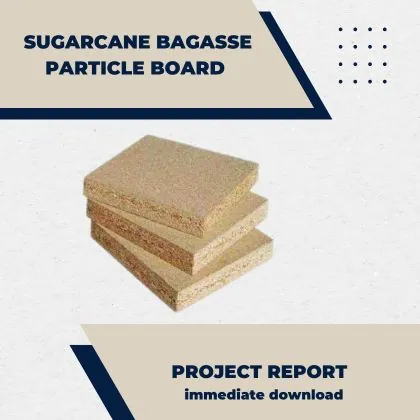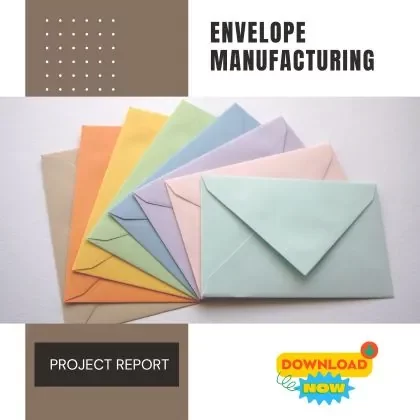Description
A paper plate making project report is a crucial document for anyone looking to start a paper plate manufacturing business. A key aspect of the project report is understanding how many paper plates can be produced from a given amount of raw material, typically ranging from 150 to 300 plates per kilogram, depending on factors like thickness and size. It provides vital details, including market analysis, financial projections, and the step-by-step process of setting up the business. This article will guide you through everything you need to create a comprehensive and effective project report for your paper plate making venture.
Key Takeaways
Table of Contents
- 1 Key Takeaways
- 2 Introduction
- 3 Why Start a Paper Plate Making Business?
- 4 Market Potential & Demand
- 5 How to Start a Paper Plate Making Business? Step-by-step process
- 6 Feasibility Report and Manufacturing Unit
- 7 Machinery and Equipment
- 8 Raw Materials Required
- 9 Manufacturing Process
- 10 Project Cost and Investment
- 11 Profitability and ROI
- 12 Government Schemes & Subsidies
- 13 Registration and Licenses
- 14 Supply Chain Management
- 15 Challenges and Solutions
- 16 Why You Need a Project Report
- 17 What’s Included in Our Project Report?
- 18 How to Get the Project Report
- 19 Conclusion
- 20 Creating a Marketing Strategy for Your Paper Plate Business
- 21 Financial Planning and Profitability Analysis
- 22 Sustainability and Waste Management in Paper Plate Manufacturing
- 23 Summary
- 24 Frequently Asked Questions
- The paper plate manufacturing business is gaining traction due to increasing demand for eco-friendly products and the global shift away from plastic.
- Starting a paper plate business requires relatively low capital investment and offers substantial market potential, both domestically and for exports.
- A comprehensive project report is essential for entrepreneurs to secure funding, outline their business strategy, and assess long-term profitability and sustainability.
Introduction
The increasing demand for eco-friendly products has paved the way for numerous sustainable business opportunities. Among these, the paper plate making business has emerged as a particularly viable option. With plastic bans being enforced globally, the shift towards biodegradable alternatives like paper plates is accelerating. This document discusses how starting a paper plate manufacturing business can be a profitable and socially responsible choice.
In addition to paper plates, the paper cup business also presents a lucrative opportunity due to similar investment requirements and growing consumer preference for environmentally friendly options.
Paper plates, being lightweight and disposable, cater to the needs of various sectors, including fast food outlets, catering businesses, and households. This guide aims to provide aspiring entrepreneurs with a detailed project report, ensuring they have all the necessary information to embark on this green and profitable journey.
Why Start a Paper Plate Making Business?
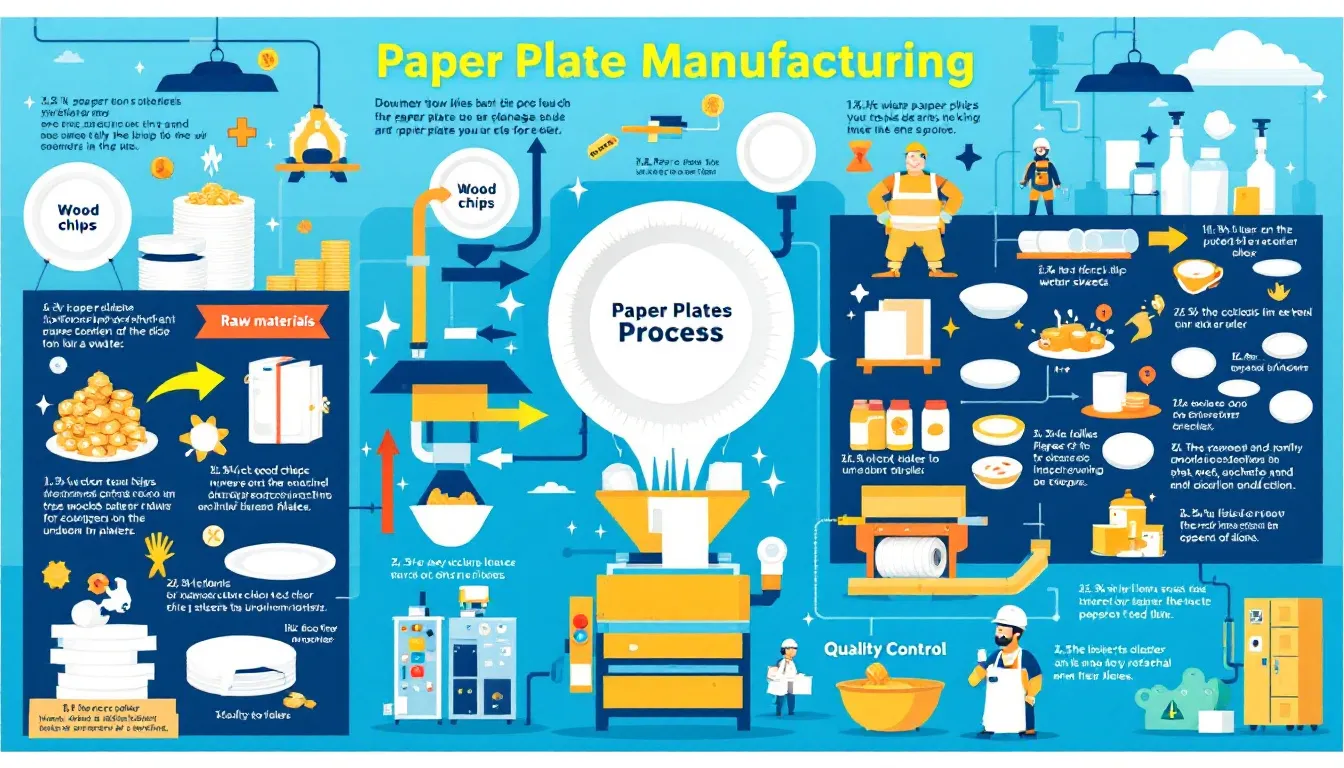
- Growing Demand: The global shift towards eco-friendly products and the ban on plastic items have increased the demand for paper plates, creating a unique business opportunity.
- Eco-Friendly and Convenient: Paper plates are biodegradable and offer convenience to consumers, ensuring consistent market demand.
- High Return on Investment: The paper plate making business promises high returns due to the growing market and relatively low production costs.
- Low Initial Investment: Compared to other manufacturing businesses, starting a paper plate manufacturing unit requires a smaller initial investment, making it accessible to many entrepreneurs.
- Government Support: There are various government incentives and subsidies available for eco-friendly manufacturing units, further reducing the financial burden on new businesses.
- Employment Opportunities: The business can be established in both rural and urban areas, providing job opportunities and contributing to local economic development.
- Scalability: The business offers scalability options, allowing entrepreneurs to expand their operations as demand increases, ensuring long-term growth potential.
The paper industry offers diverse applications, including the production of craft paper, corrugated boxes, and tissue products, making it a versatile and profitable sector to enter.
Market Potential & Demand
- Vast Market Potential: The paper plate business has a large and expanding market. Domestically, demand is driven by sectors like catering businesses, sweet shops, and small restaurants that need a constant supply of disposable tableware.
- Continuous Demand: Institutional buyers require a steady supply of paper plates, ensuring ongoing demand for paper plate manufacturing businesses.
- Export Opportunities: There are significant export possibilities, especially in countries with strict environmental regulations, presenting lucrative markets for eco-friendly products like paper plates.
- Scalability: The paper plate making business offers scalability, allowing entrepreneurs to expand operations as demand increases, making it a promising venture.
How to Start a Paper Plate Making Business? Step-by-step process
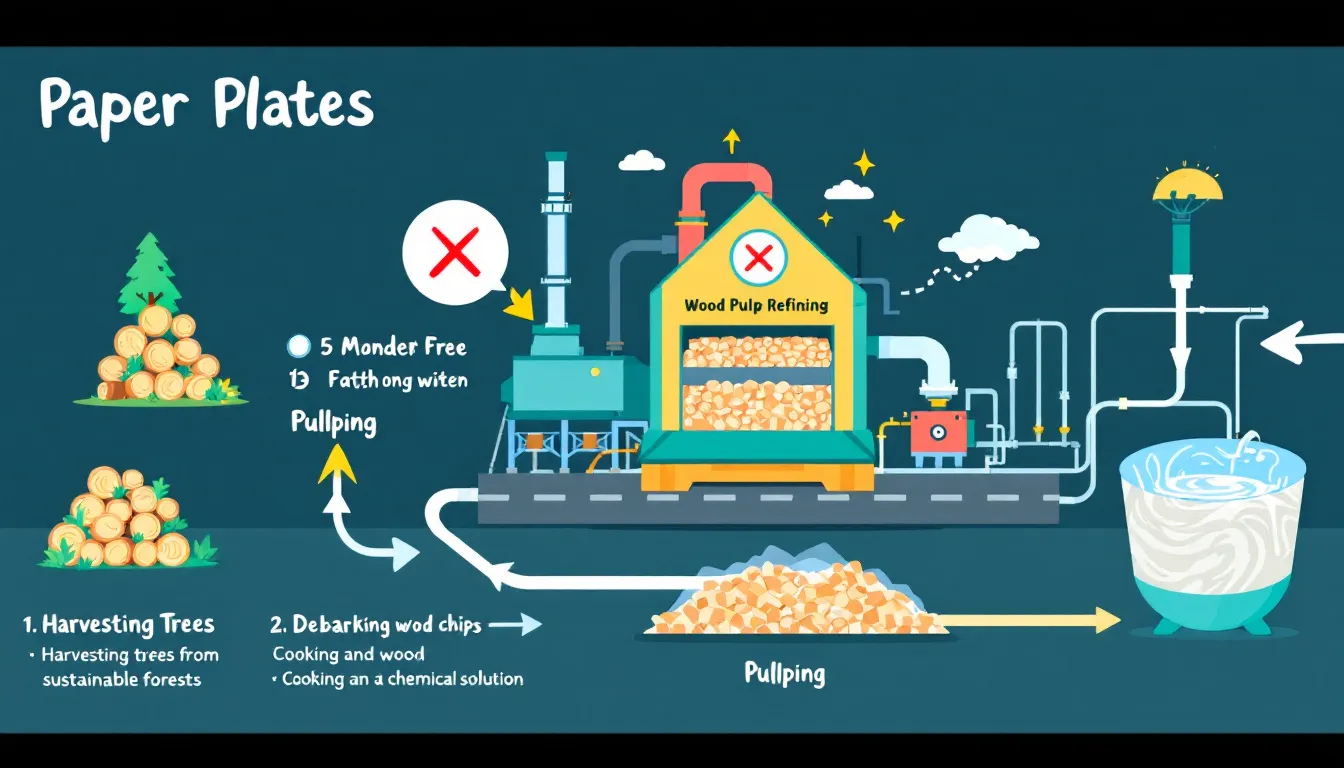
Starting a paper plate making business involves several critical steps:
- Business Registration and Licensing:
- Register your business to ensure legal compliance.
- Obtain necessary licenses and permits to qualify for government support and subsidies.
- Location Selection:
- Secure a suitable location with adequate space for machinery and storage.
- Ensure access to reliable electricity and water supplies for smooth production processes.
- Sourcing Raw Materials:
- Procure paper rolls or sheets, dies, and molds from reputable suppliers.
- Ensure a steady supply of high-quality raw materials for consistent production.
- Hiring Workforce:
- Employ skilled workers to ensure efficient operations and high-quality output.
- Machinery Installation:
- Choose between manual, semi-automatic, or fully automatic machines based on production needs.
- Install machinery and provide training to maximize efficiency.
- Production Setup:
- Set up the production line, ensuring all equipment is properly installed and tested.
- Implement quality control measures to maintain product standards.
- Marketing and Distribution:
- Develop a marketing strategy to reach target customers, including catering businesses and local vendors.
- Establish distribution channels to ensure products reach the market efficiently.
Following these steps will help establish a solid foundation for your paper plate manufacturing business.
Feasibility Report and Manufacturing Unit
A feasibility report is a crucial document that assesses the viability of a paper plate making business. It evaluates the technical, financial, and operational aspects of the project to determine its potential for success. The report should include an analysis of the market demand, competition, and potential customers.
To establish a manufacturing unit for paper plates, you will need to consider the following factors:
- Location: The location of the manufacturing unit should be easily accessible and have a reliable supply of raw materials. Proximity to suppliers and customers can reduce transportation costs and improve efficiency.
- Machinery: You will need to purchase or lease machinery specifically designed for paper plate making. The machinery should be capable of producing high-quality paper plates at a reasonable cost. Options include manual, semi-automatic, and fully automatic machines, each with varying production capacities and costs.
- Raw Materials: Sourcing high-quality raw materials is essential for producing durable and attractive paper plates. Key materials include paper rolls or sheets, which can be silver laminated or plain, as well as dies and molds for shaping the plates.
- Labor: Hiring skilled laborers who can operate the machinery and produce paper plates efficiently is crucial. Providing training to your workforce can enhance productivity and ensure high-quality output.
- Quality Control: Establishing a quality control process is vital to ensure that the paper plates meet the required standards. Regular inspections and testing can help maintain consistency and customer satisfaction.
By carefully considering these factors, you can set up a manufacturing unit that is efficient, cost-effective, and capable of meeting market demand.
Machinery and Equipment
The machinery and equipment required for a paper plate manufacturing unit can vary based on the scale of production. Here are the key points:
- Types of Machines:
- Manual Machines: Suitable for small-scale operations.
- Semi-Automatic Machines: Ideal for medium-scale production.
- Fully Automatic Machines: Best for larger production capacities.
- Output Capacity:
- Automatic machines offer higher efficiency and productivity compared to manual and semi-automatic options. Fully automatic machines can produce a higher number of plates per hour compared to manual and semi-automatic options, significantly boosting overall productivity.
- Cost Considerations:
- Manual machines are the least expensive.
- Fully automatic machines are the most costly but offer increased production capacity and reduced labor costs.
- Installation and Training:
- Proper installation and training are essential to ensure smooth operations and maximize machinery efficiency.
Raw Materials Required
The primary raw materials for paper plate making include:
- Paper Rolls or Sheets:
- Available in silver laminated or plain varieties.
- Fundamental for production; quality impacts final product.
- The quality of the paper material, whether it is kraft paper or laminated sheets, is crucial for producing durable and cost-effective paper plates.
- Dies and Molds:
- Essential for determining the shape and size of plates.
- Must be sourced from reliable suppliers for consistency.
- Packaging Materials:
- Necessary for secure packing and distribution.
- Protects plates during transit and enhances market appeal.
Ensuring a steady supply of these materials is crucial for uninterrupted production and meeting market demand.
Manufacturing Process
The manufacturing process of paper plates involves several key stages:
- Loading Raw Material: Paper rolls or sheets are loaded into the machine.
- Molding and Cutting: Paper is molded and cut into desired shapes and sizes using dies and molds. Precision is crucial to ensure uniformity and high quality of the plates.
- Finishing Processes: Includes trimming and edge smoothing to enhance appearance and usability.
- Packaging: Finished plates are packaged for distribution.
- Waste Handling: Proper management and recycling of leftover materials are integral to the process.
Project Cost and Investment
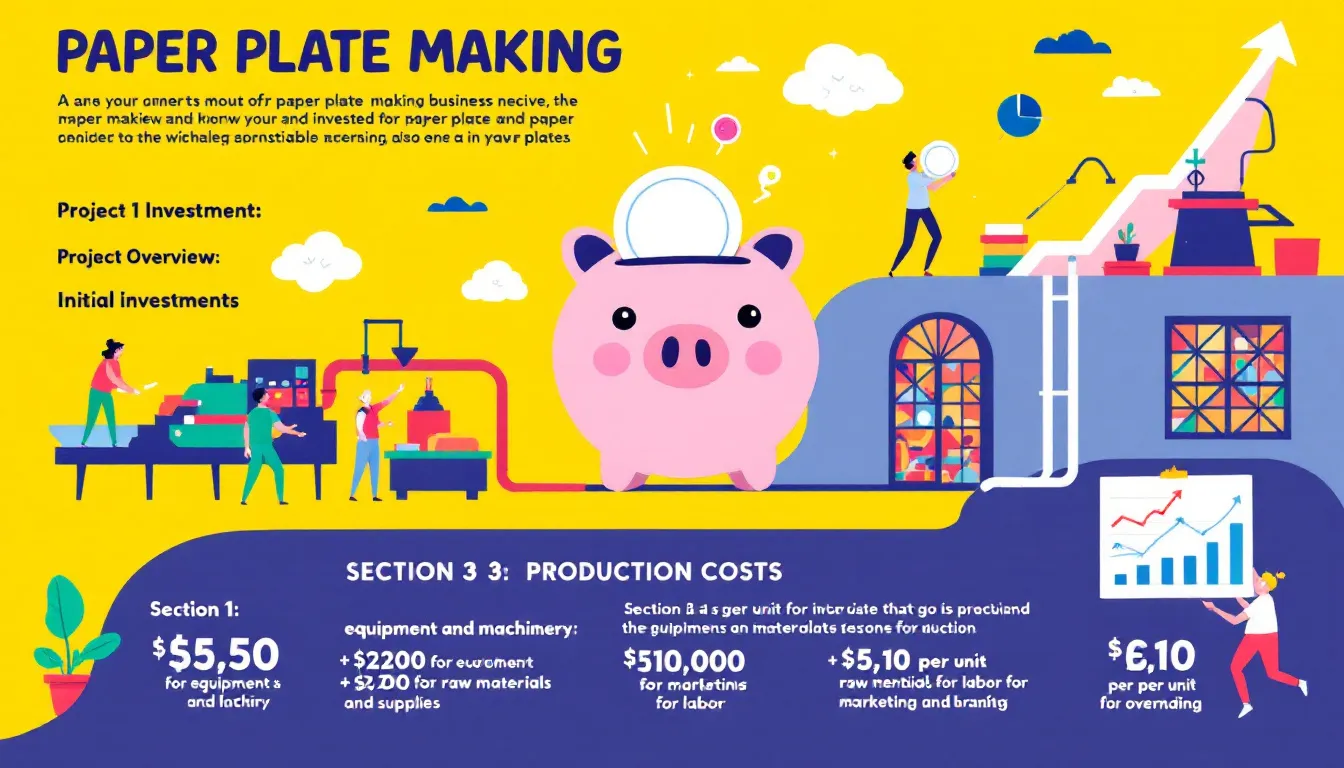
Setting up a paper plate manufacturing business involves careful financial planning, encompassing both fixed and working capital investments. Here are the key points to consider:
- Fixed Capital Investment:
- Machinery and Equipment: Costs vary based on the type of machinery (manual, semi-automatic, or fully automatic) and scale of production.
- Production Unit Setup: Includes expenses for setting up the manufacturing facility, such as construction, electrical installations, and other infrastructure needs.
- Working Capital Investment:
- Raw Materials: Recurring expenses for purchasing paper rolls, dies, and other necessary materials.
- Salaries and Wages: Payment for skilled workers and administrative staff.
- Utilities: Ongoing costs for electricity, water, and other essential services.
- Example Project Cost for Small-Scale Unit:
- Semi-Automatic Machine Purchase: Initial machinery investment suitable for moderate production capacity.
- Initial Raw Material Stock: Sufficient for starting production and meeting initial market demand.
- Setup Costs: Includes costs for establishing the manufacturing unit and ensuring operational readiness.
- Similar investment considerations apply to the paper cup manufacturing business, which also offers significant market potential and profitability.
- Financial Support:
- Bank Loans and Investor Funding: A detailed project report can help secure financial assistance by outlining the business plan and financial projections.
By understanding these components, entrepreneurs can effectively plan their investments and secure the necessary financial support to launch their paper plate manufacturing business.
Profitability and ROI
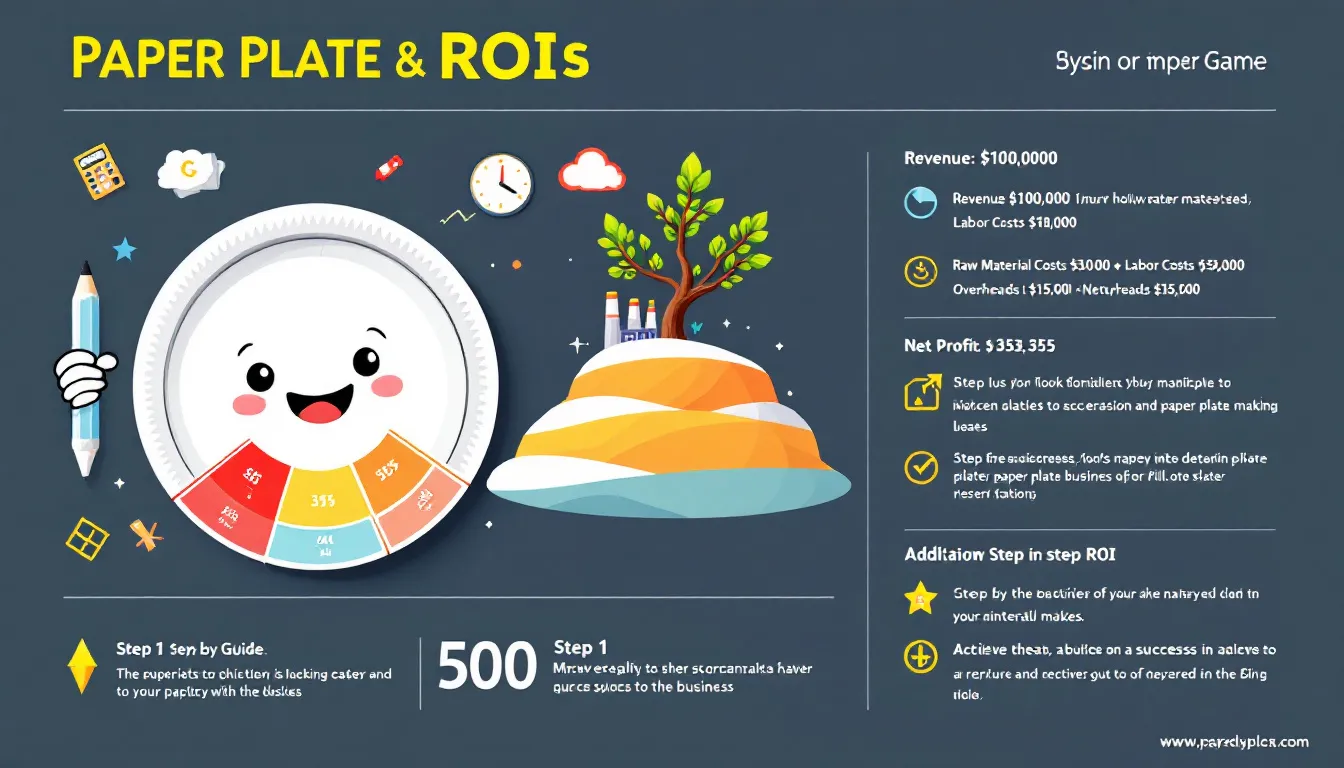
- Production Capacity: The profitability of a paper plate manufacturing business is heavily influenced by its production capacity. Higher production levels typically lead to increased profits.
- Cost of Raw Materials: The cost of procuring raw materials like paper rolls and dies significantly impacts profit margins. Efficient sourcing can reduce costs and enhance profitability.
- Selling Price: Setting a competitive selling price that reflects the quality of the product can maximize profit margins while attracting customers.
- Profit Margin: The difference between the cost of production and the selling price determines the profit margin, which can be quite attractive in the paper plate industry.
- The process of selling paper plates involves navigating a competitive market with established sellers, but strategic marketing and quality products can help capture market share.
- Monthly Profit Estimations: Regularly calculating expected revenue and deducting production costs helps business owners gauge monthly profits and plan for future growth.
- Break-even Period: Understanding the break-even period is crucial as it indicates how long it will take for the business to recover its initial investment and start generating profit.
Government Schemes & Subsidies
- Support for SMEs: The Indian government offers various schemes and subsidies to aid small and medium enterprises (SMEs) in the manufacturing sector.
- Mudra Loan Scheme: Provides financial assistance for purchasing machinery and equipment essential for paper plate making.
- PMEGP: The Prime Minister’s Employment Generation Programme (PMEGP) offers support for setting up new manufacturing units and expanding existing ones.
- MSME Schemes: Additional support is available through various MSME schemes designed to foster growth and development in the manufacturing industry.
- Application Process: Entrepreneurs need to understand the eligibility criteria and application process for these schemes.
- Project Report Importance: A detailed project report is crucial for presenting a business plan and financial projections, enhancing the chances of securing financial support.
Registration and Licenses
To start a paper plate making business in India, you will need to obtain the following registrations and licenses:
- Company Registration: Register your company with the Registrar of Companies (ROC) and obtain a Certificate of Incorporation. This legalizes your business and allows you to operate officially.
- GST Registration: Register for Goods and Services Tax (GST) and obtain a GSTIN. This is mandatory for businesses in India and enables you to collect and remit GST on your sales.
- Udyam Registration: Register your business under the Micro, Small and Medium Enterprises (MSME) Act and obtain a Udyam Registration Certificate. This provides access to various government schemes and subsidies designed to support small businesses.
- Shop and Establishment Act License: Obtain a license under the Shop and Establishment Act to operate your business. This license regulates working conditions and ensures compliance with labor laws.
- Environmental Clearance: Obtain environmental clearance from the State Pollution Control Board to operate your manufacturing unit. This ensures that your business complies with environmental regulations and minimizes its impact on the environment.
By securing these registrations and licenses, you can ensure that your paper plate making business operates legally and benefits from government support.
Supply Chain Management
Supply chain management is critical to the success of a paper plate making business. Establishing relationships with reliable suppliers of raw materials, such as paper rolls, glue, and ink, is essential. Additionally, setting up a distribution network to supply your paper plates to customers is crucial for business growth.
To manage your supply chain effectively, consider the following strategies:
- Just-in-Time (JIT) Production: Adopt a JIT production system to produce paper plates only when they are needed. This reduces inventory costs and minimizes waste, ensuring that resources are used efficiently.
- Vendor Management: Establish relationships with reliable vendors who can supply high-quality raw materials at competitive prices. Regularly evaluate vendor performance to ensure consistency and reliability.
- Logistics Management: Implement a logistics management system to ensure that your paper plates are delivered to customers on time and in good condition. Efficient logistics can enhance customer satisfaction and reduce transportation costs.
- Inventory Management: Establish an inventory management system to track your stock levels and ensure that you have sufficient inventory to meet customer demand. This helps prevent stockouts and overstocking, optimizing your resources.
By focusing on these strategies, you can create a robust supply chain that supports the efficient production and distribution of your paper plates, ensuring the success of your business.
Challenges and Solutions
- Raw Material Availability: Ensuring a steady supply of high-quality paper rolls is crucial for maintaining production.
- Market Competition: The growing demand for eco-friendly products has led to increased competition in the market.
- Quality Control: Maintaining high product standards is essential to stand out in a competitive market.
- Branding and Identity: Building a strong brand identity helps attract and retain customers.
- Solutions: Implement effective quality control measures and invest in branding efforts to overcome these challenges.
Why You Need a Project Report
- Essential for Financial Support: A detailed project report is crucial for securing loans and financial backing from banks and investors.
- Comprehensive Business Plan: It outlines the business strategy, including market analysis and financial projections, aiding in informed decision-making.
- Feasibility Assessment: The inclusion of a feasibility report helps assess the business’s viability, providing a complete overview of expected costs, revenues, and profitability.
- Effective Planning and Budgeting: Helps entrepreneurs plan and budget effectively, ensuring all financial aspects are covered for a successful paper plate manufacturing business.
What’s Included in Our Project Report?
Our project report is meticulously crafted to include all the essential components needed for a successful paper plate manufacturing business. Key points covered in the report are:
- Executive Summary: Provides a concise overview of the business plan.
- Market Analysis: Offers insights into demand, competition, and potential growth opportunities.
- Technical Details: Includes specifications and costs of machinery to aid in informed purchasing decisions.
- Financial Projections: Covers the next five years, including break-even and ROI calculations, to outline the business’s profitability.
- Bank Loan Proposals: Contains formats for proposals and a loan repayment schedule to facilitate securing financial support.
How to Get the Project Report
Obtaining our comprehensive project report is straightforward. You can download it directly from our website in PDF document format. The report is priced competitively to ensure affordability for aspiring entrepreneurs, and support is available for customization to meet specific business needs.
By investing in this detailed project report, you can save time, money, and effort in setting up your paper plate manufacturing business. It provides all the necessary information and tools to help you succeed in this lucrative industry.
Conclusion
Embarking on a paper plate making business is a step towards a sustainable and profitable future. The growing consumer awareness about eco-friendly products provides a solid foundation for this venture. A well-prepared project report is crucial for summarizing key findings, outlining potential benefits, and demonstrating financial viability to stakeholders.
Taking the first step can be daunting, but with the right information and resources, you can turn this business ideas into a thriving enterprise. Our detailed project report can save you time, money, and effort, providing a clear roadmap to success.
If you have any questions or need further assistance, feel free to ask in the comment section below.
Creating a Marketing Strategy for Your Paper Plate Business
A strong marketing strategy is crucial for standing out in the competitive paper plate business. Here are key points to consider:
- Brand Identity: Establish a solid brand identity to enhance customer recognition and trust.
- Local Distribution: Focus on local distribution to effectively reach vendors and caterers.
- Target Peak Occasions: Target peak occasions like festivals and weddings to boost profitability due to increased demand.
- Target Market: Identify and understand your target market, including catering businesses and event organizers.
- Competitive Pricing Strategy: Set a competitive pricing strategy by analyzing production costs, market demand, and competitors’ prices.
- Promotion and Sales Channels: Utilize effective promotion and sales channels, including digital marketing and trade shows.
- Customer Engagement: Engage with potential customers through promotions, discounts, and special offers.
By focusing on these elements, you can create a robust marketing strategy that positions your paper plate manufacturing business for success.
Identifying Target Market
Identifying the target market is a crucial step in creating an effective marketing strategy. Catering businesses form a core segment of the target audience due to their high demand for disposable tableware. These businesses often require large quantities of paper plates for events, making them significant potential clients.
Local events and parties are also key occasions where paper plates are commonly utilized. Event organizers, food vendors, and catering services represent key customer segments that should be targeted in your marketing efforts. By understanding the needs and preferences of these customers, you can tailor your production and sales strategies to meet their demands effectively.
Pricing Strategy
A well-defined pricing strategy is critical to the success of your paper plate business. Setting prices that reflect the quality and uniqueness of your products can help distinguish them in a crowded market. Establishing competitive prices requires a thorough analysis of production costs, market demand, and competitors’ prices. By maintaining a balance between affordability and profitability, you can attract customers while ensuring sustainable margins.
Profitability can be enhanced by carefully considering costs and market prices. A comprehensive pricing strategy not only improves competitive positioning but also enhances the overall profitability of the business. Regularly reviewing and adjusting prices based on market trends and cost fluctuations will help maintain a healthy profit margin.
Promotion and Sales Channels
Promotion and sales channels play a vital role in maximizing the reach and sales of your paper plate products. Attending trade shows and industry events can serve as excellent opportunities to network and showcase your products to potential buyers. Effective promotional tactics, such as discounts during peak seasons and special offers for bulk purchases, can attract more customers.
The market dynamics of paper cups, including their segmentation into hot and cold cups, also offer valuable insights for developing targeted marketing strategies.
Utilizing digital marketing strategies, including social media advertising and search engine optimization, can significantly enhance your business’s visibility and reach. Developing strong relationships with distributors and retailers will also create effective sales channels, ensuring that your paper plates are available to a broader audience.
Financial Planning and Profitability Analysis
Financial planning and profitability analysis are essential components for the success of your paper plate manufacturing business. A detailed project report will provide insights into the initial investment required, expected profit margins, and the feasibility of the business. This section will cover the financial aspects in detail, helping you to plan and budget effectively.
Understanding the financial requirements, including the costs of machinery, raw materials, and operating expenses, will aid in creating a robust business plan. Additionally, analyzing market trends and production costs will give an indication of expected profits and help you develop competitive pricing strategies.
Initial Investment
The initial investment for a paper plate making business includes capital for equipment, raw materials, and operating costs. Essential machinery such as hydraulic plate machines and die-cutting machines are necessary, with costs varying based on features and production capacity. Additional equipment like cutting tools and packaging machines also contribute to the overall investment, enhancing production efficiency.
Operating costs include recurring expenses such as raw materials, labor, utilities, and maintenance. Ensuring a steady supply of high-quality paper rolls from reliable suppliers is crucial for consistent production. By analyzing market trends and production costs, you can estimate profit margins and plan for a successful business.
Sustainability and Waste Management in Paper Plate Manufacturing

Sustainability and waste management are critical considerations in the paper plate manufacturing business. Using eco-friendly materials and implementing waste reduction techniques can significantly impact your business’s environmental footprint. Sourcing recycled paper as a raw material not only reduces costs but also supports sustainability.
Investing in advanced machinery and establishing a clear brand identity that emphasizes eco-friendliness can attract environmentally conscious consumers. By adopting sustainable practices, you can enhance your profit margins while contributing positively to the environment.
Eco-Friendly Materials
Using biodegradable materials in paper plate production helps to reduce environmental pollution. Common biodegradable materials include plant fibers and recycled paper, which are both sustainable and effective for producing high-quality paper plates. Recyclable materials such as used paper and cardboard can also be utilized, minimizing waste and promoting eco-friendly practices.
Utilizing biodegradable and recyclable materials not only contributes to sustainable practices but also decreases the carbon footprint of the production process. This approach aligns with the growing consumer demand for eco-friendly products and can enhance your brand’s reputation.
Waste Reduction Techniques
Establishing programs to recycle production scraps can significantly decrease landfill contributions and promote a circular economy in the paper plate industry. By recycling production scraps, you can minimize waste and reduce the environmental impact of your manufacturing process.
Implementing waste reduction techniques such as optimizing material usage and improving production efficiency can further enhance sustainability. These practices not only benefit the environment but also reduce production costs, contributing to the overall profitability of your business.
Recycling Initiatives
Recycling scrap materials from the paper plate production process plays a crucial role in minimizing waste and lowering environmental impact. By promoting recycling initiatives, paper plate manufacturers can contribute to sustainable practices within the industry.
Implementing a recycling system allows manufacturers to reuse paper scraps, reducing raw material costs and waste. Engaging in community recycling programs can increase awareness and participation in sustainable practices, benefiting the overall environment.
Summary
In summary, starting a paper plate making business offers a unique opportunity to tap into the growing demand for eco-friendly products. By understanding the market potential, investment requirements, and manufacturing processes, you can set a solid foundation for a successful venture. The comprehensive project report discussed in this blog post provides all the necessary information to navigate the complexities of this business.
Taking the first step towards this sustainable and profitable business can be daunting, but with the right resources and guidance, you can turn this idea into a thriving enterprise. By leveraging government support, implementing effective marketing strategies, and adopting sustainable practices, you can ensure the long-term success and growth of your paper plate manufacturing business.
Frequently Asked Questions
What are the initial steps to start a paper plate making business?
To start a paper plate making business, register your business, secure a location with reliable utilities, source raw materials, and hire skilled workers. These foundational steps are crucial for a successful launch.
How much investment is required for a small-scale paper plate manufacturing unit?
A small-scale paper plate manufacturing unit typically requires an investment ranging from $10,000 to $50,000, which covers semi-automatic machinery, raw materials, and setup costs.
What are the key raw materials needed for paper plate production?
The key raw materials for paper plate production are paper rolls or sheets, which can be silver laminated or plain, along with dies and molds for shaping, and packaging materials.
How can I make my paper plate business sustainable?
To make your paper plate business sustainable, focus on using biodegradable and recyclable materials, implement waste reduction techniques, and promote recycling initiatives. These steps will significantly enhance your environmental impact.
Why is a detailed project report important for starting a paper plate manufacturing business?
A detailed project report is crucial for securing financing, effectively planning your operations, and evaluating the feasibility and profitability of your paper plate manufacturing business. It serves as a roadmap for your venture, ensuring informed decisions and strategic growth.

